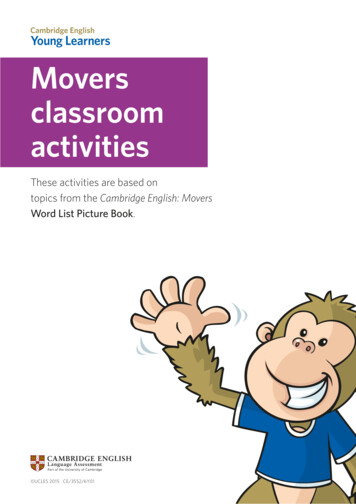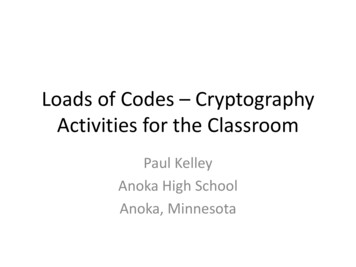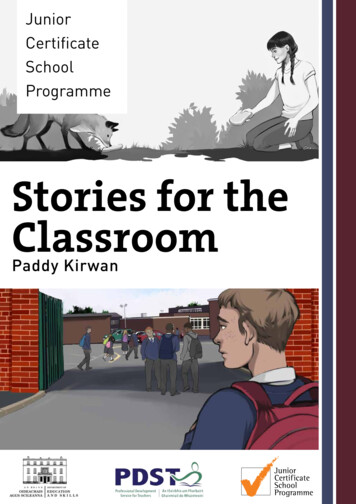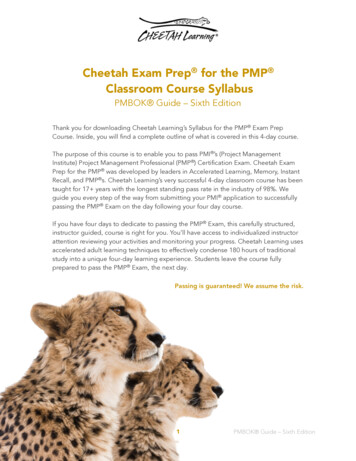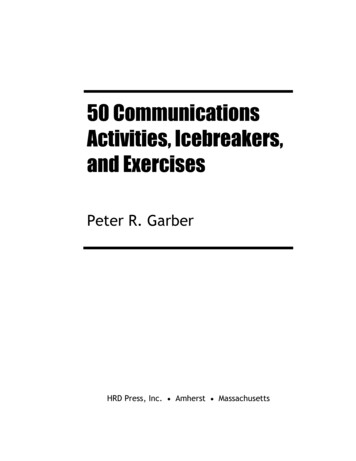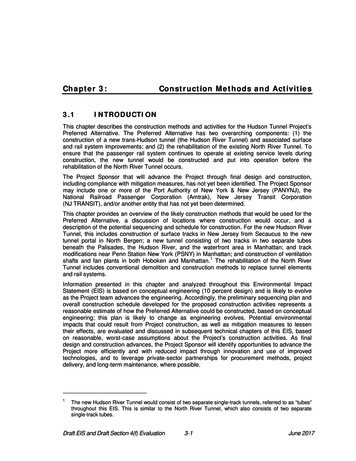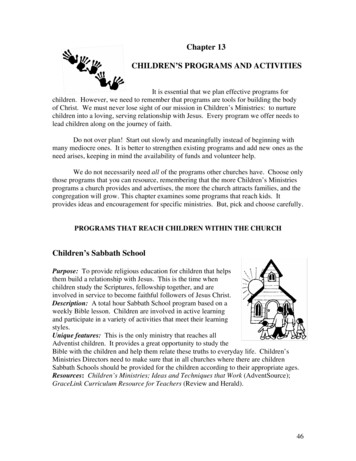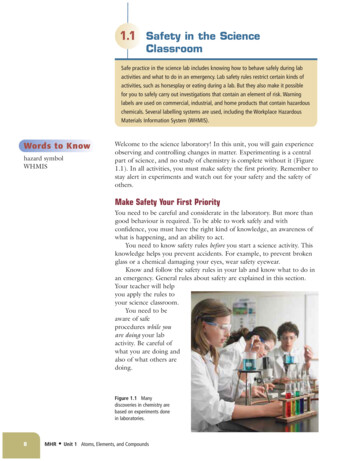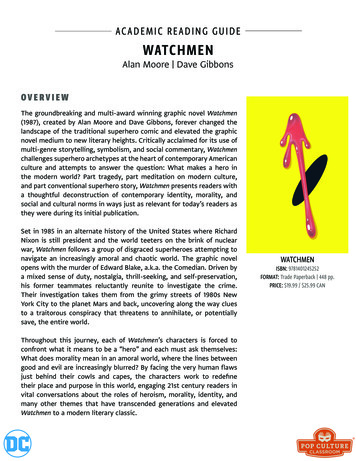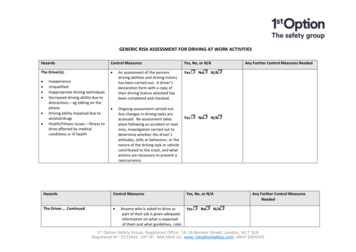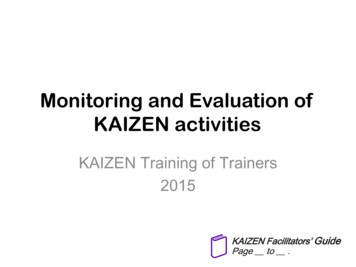
Transcription
Classroom Activities fromCritical Encounters in Secondary English:Teaching Literary Theory to AdolescentsTHIRD EDITIONby Deborah ApplemanCopyright 2015 by Teachers College, Columbia UniversityNote to teachers: Several of the activities include the original terms Feminist andMarxist, rather than or in addition to gender and social power/class. Teachers shouldfeel free to adapt the materials for their classrooms.Activity 1:“Little Miss Muffet,” by Russell Baker3Activity 2: Group Exercise for John Updike's “Separating”5Activity 3: A Matter of Perspective6Activity 4: Literary Perspectives Toolkit7Activity 5: Literary Theories: A Sampling of Critical Lenses11Activity 6: Literary Theory Cards15Activity 7: TheoryWars: Looking at Star Wars Through Critical Lenses21Activity 8: Literary Theory: Prisms of Possibilities22Activity 9: Upon Seeing an Orange23Activity 10: Looking Through Lenses: Our First Look24Activity 11: Reader-Response Chart26Activity 12: Reader Response and Native Son27Activity 13: Key Ideas of Marx28Activity 14: Reading Hamlet Through the Marxist/Social Class Lens30Activity 15: Blue Collar Brilliance:Using Literary Lenses to Read Nonfiction34
Activity 16: Dumpster Diving:Using Literary Lenses to Read Nonfiction36Activity 17: Looking at The Great Gatsby Through Critical Lenses39Activity 18: What Color Are Your Walls? The Feminist/Gender Lens43Activity 19: A Lens of One’s Own:Using Feminist/Gender Literary Theory45Activity 20: Death of a Salesman and the Social Construction of Gender48Activity 21: Getting to the Heart of the “Other”:The Postcolonial Lens and Heart of Darkness53Activity 22: Reading Nonfiction and Art:A New Historical Approach57Activity 23: The Interplay of Nonfiction and Poetry59Activity 24: Deconstruction60Activity 25: A Modest Proposal: Deconstruction and Nonfiction64Activity 26: “On the Subway,” by Sharon Olds: The Gender Lens66Activity 27: “On the Subway,” by Sharon Olds:The Formalist or New Critical Lens67Activity 28: “On the Subway,” by Sharon Olds: The Social Class Lens68Activity 29: “On the Subway,” by Sharon Olds:The Reader-Response Lens69Activity 30: “Ode to Family Photographs”: Three Perspectives70Activity 31: Literary Theory: Among the Things We Carry71Activity 32: Contemporary Literary Theory and Shrek73Activity 33: The Interplay of Fiction and Nonfiction75Activity 34: From Reading Words to Reading the World:Critical Lenses in Literature and in Life77Activity 35: Critical Encounters: Reading the World79Activity 36: Theory Relay: Native Son81Activity 37: Through Rose-Colored Glasses:The Feminist/Gender Lens83
Activity 1LittleMissMuffetRussell BakerOne of the fascinating aspects of American English is its diversity, and one of thecauses of this diversity is the specialized vocabularies of different occupations inAmerica. Russell Baker’s report of a conference dealing with Little Miss Muffet, taken from Poor Russell’s Almanac, illustrates several varieties of occupational jargon.Little Miss Muffet, as everyone knows, sat on a tuffet eating her curds and wheywhen along came a spider who sat down beside her and frightened Miss Muffetaway. While everyone knows this, the significance of the event had never been analyzed until a conference of thinkers recently brought their special insights to bearupon it. Following are excerpts from the transcript of their discussion:Sociologist: We are clearly dealing here with a prototypical illustration of a highlytensile social structure’s tendency to dis- or perhaps even de-structure itself underthe pressures created when optimum minimums do not obtain among the disadvantaged. Miss Muffet is nutritionally underprivileged, as evidenced by the subliminaldiet of curds and whey upon which she is forced to subsist, while the spider’s culturaldisadvantage is evidenced by such phenomena as legs exceeding standard norms,odd mating habits, and so forth.In this instance, spider expectations lead the culturally disadvantaged to assertdemands to share the tuffet with the nutritionally underprivileged. Due to a communications failure, Miss Muffet assumes without evidence that the spider will notbe satisfied to share her tuffet, but will also insist on eating her curds and perhapseven her whey. Thus, the failure to pre-establish selectively optimum norm structuresdiverts potentially optimal minimums from the expectation levels assumed to. . .Militarist: Second-strike capability, sir! That’s what was lacking. If Miss Muffethad developed a second-strike capability instead of squandering her resources oncurds and whey, no spider on earth would have dared launch a first strike capableof carrying him right to the heart of her tuffet. I am confident that Miss Muffet hadClassroom Activities: Critical Encounters in Secondary English, 3rd Edition, by Deborah Appleman3
adequate notice from experts that she could not afford both curds and whey and,at the same time, support an early-spider-warning system. Yet curds alone were notgood enough for Miss Muffet. She had to have whey, too. Tuffet security must be thefirst responsibility of every diner . . .Book Reviewer: Written on several levels, this searing and sensitive exploration ofthe arachnid heart illuminates the agony and splendor of Jewish family life with acandor that is at once breathtaking in its simplicity and soul-shattering in its impliedambiguity. Some will doubtless be shocked to see such subjects as tuffets and wheydiscussed without flinching, but hereafter writers too timid to call a curd a curd willno longer. . .Editorial Writer: Why has the government not seen fit to tell the public all it knowsabout the so-called curds-and-whey affair? It is not enough to suggest that this wasmerely a random incident involving a lonely spider and a young diner. In today’sworld, poised as it is on the knife edge of . . .Psychiatrist: Little Miss Muffet is, of course, neither little or a miss. These are obvi-ously the self she has created in her own fantasies to escape the reality that she is agross divorcee whose superego makes it impossible for her to sustain a normal relationship with any man, symbolized by the spider, who, of course, has no existenceoutside her fantasies. Little Miss Muffet may, in fact, be a man with deeply repressedOedipal impulses, who sees in the spider the father he would like to kill, and verywell may some day, unless he admits that what he believes to be a tuffet is, in fact,probably the dining room chandelier, and that what he thinks he is eating is, in fact,probably . . .Student Demonstrator: Little Miss Muffet, tuffets, curds, whey and spiders arewhat’s wrong with education today. They’re all irrelevant. Tuffets are irrelevant.Curds are irrelevant. Whey is irrelevant. Meaningful experience! How can you haverelevance without meaningful experience? And how can there ever be meaningfulexperience without understanding? With understanding and meaningfulness and relevance, there can be love and good and deep seriousness and education today willbe freed of slavery and Little Miss Muffet, and life will become meaningful and . . .Child: This is about a little girl who gets scared by a spider. (The child was sent homewhen the conference broke for lunch. It was agreed that he was too immature tosubtract anything from the sum of human understanding.)4Classroom Activities: Critical Encounters in Secondary English, 3rd Edition, by Deborah Appleman
Activity 2Group Exercise for John Updike's “Separating”Read John Updike’s “Separating” on your own. Then, get into groups of three orfour and work together on the following questions.1. List all the characters that appear in the story.2. From whose point of view is the story told?3. Summarize the story from that character’s point of view. That is, according tothe character you named in Question 2, what happens in this story?4. Now, pick another character from those you listed in Question 1. Summarize thestory from the viewpoint of that character.5. Reread the last two paragraphs of the story. Speculate together on what willhappen next. Is there any reason to believe that Richard and Joan might notseparate?6. Extend the story. Write at least one page from the point of view of the characteryou used in Question 4.Classroom Activities: Critical Encounters in Secondary English, 3rd Edition, by Deborah Appleman5
ACTIVITY 3A Matter of PerspectiveLet’s explore the notion of perspective. Much contemporary fiction violates traditional narrative expectations by telling the story from the perspective of a variety ofcharacters, rather than from the perspective of a single protagonist.1. Tell the story of “The Three Little Pigs.”2. Now, look at the children’s book The True Story of the Three Little Pigs, AsTold by A. Wolf. What differences does that switch in perspective make?3. Think of a family story, preferably one that is retold often, a part of your familymythology. In a paragraph or so, tell that story from your own perspective.Write your version below.4. Now, think of another family member, and retell the story from his/herperspective. Write that version below.Family Member:5. In groups of no more than four, share those stories and discuss the differenceperspective makes. How can we know what is the “true” version of the story?6Classroom Activities: Critical Encounters in Secondary English, 3rd Edition, by Deborah Appleman
Activity 4LiteraryPerspectivesToolkitLiterary perspectives help us explain why people might interpret the same text ina variety of ways. Perspectives help us understand what is important to individualreaders, and they show us why those readers end up seeing what they see. One wayto imagine a literary perspective is to think of it as a lens through which we canexamine a text. No single lens gives us the clearest view, but it is sometimes fun toread a text with a particular perspective in mind because you often end up seeingsomething intriguing and unexpected. While readers typically apply more than oneperspective at a time, the best way to understand these perspectives is to use themone at a time. What follows is a summary of some of the best-known literary perspectives. These descriptions are extremely brief, and none fully explains everythingyou might want to know about the perspective in question, but there is enough herefor you to get an idea about how readers use them.Reader-Response Perspective: This type of perspective focuses on the activity ofreading a work of literature. Reader-response critics turn away from the traditionalidea that a literary work is an artifact that has meaning built within it; they turn theirattention instead to the responses of individual readers. By this shift of perspective,a literary work is converted into an activity that goes on in a reader’s mind. It isthrough this interaction that meaning is made. The features of the work itself—including narrator, plot, characters, style, and structure—are less important than theinterplay between a reader’s experience and the text. Advocates of this perspectivebelieve that literature has no inherent or intrinsic meaning waiting to be discovered.Instead, meaning is constructed by readers as they bring their own thoughts, moods,and experiences to whatever text they are reading. In turn, what readers get out ofa text depends upon their own expectations and ideas. For example, if you read“Sonny’s Blues” by James Baldwin and you have your own troubled younger brotheror sister, the story will have meaning for you that it wouldn’t have for, say, an onlychild.Classroom Activities: Critical Encounters in Secondary English, 3rd Edition, by Deborah Appleman7
The Archetypal Perspective: In literary criticism, the word archetype signifies a recognizable pattern or a model. It can be used to describe story designs, charactertypes, or images that can be found in a wide variety of works of literature. It can alsobe applied to myths, dreams, and social rituals. The archetypal similarities amongtexts and behaviors are thought to reflect a set of universal, even primitive ways ofseeing the world. When we find them in literary works they evoke strong responsesfrom readers. Archetypal themes include the heroic journey and the search for afather figure. Archetypal images include the opposition of Paradise and Hades, theriver as a sign of life and movement, and mountains or other high places as sources of enlightenment. Characters can be archetypal as well, like the rebel-hero, thescapegoat, the villain, and goddess.The Formalist Perspective: The word formal has two related meanings, both ofwhich apply within this perspective. The first relates to its root word form, a shapeof structure that we can recognize and use to make associations. The second relatesto a set of conventions or accepted practices. Formal poetry, for example, has meter, rhyme, stanza, and other predictable features that it shares with poems of thesame type. The formalist perspective, then, pays particular attention to these issuesof form and convention. Instead of looking at the world in which a poem exists, forexample, the formalist perspective says that a poem should be treated as an independent and self-sufficient object. The methods used in this perspective are those ofclose reading, a detailed and subtle analysis of the formal components that make upthe literary work, such as the meanings and interactions of words, figures of speech,and symbols.The Character Perspective: Some literary critics call this the psychological perspec-tive because its purpose is to examine the internal motivations of literary characters.When we hear actors say that they are searching for their character’s motivation,they are using something like this perspective. As a form of criticism, this perspectivedeals with works of literature as expressions of the personality, state of mind, feelings, and desires of the author or of a character within the literary work. As readers,we investigate the psychology of a character or an author to fig
Activity 15: Blue Collar Brilliance: Using Literary Lenses to Read Nonfiction 34. Activity 16: Dumpster Diving: Using Literary Lenses to Read Nonfiction 36 Activity 17: Looking at The Great Gatsby Through Critical Lenses 39 Activity 18: What Color Are Your Walls? The Feminist/Gender Lens 43 Activity 19: A Lens of One’s Own: Using Feminist/Gender Literary Theory 45 Activity 20: Death of a .
